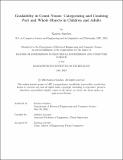Gradability in Count Nouns: Categorizing and Counting Part and Whole Objects in Children and Adults
Author(s)
Sanchez, Karissa
DownloadThesis PDF (2.402Mb)
Advisor
Aravind, Athulya
Terms of use
Metadata
Show full item recordAbstract
Some of the first words that children can comprehend and produce are nouns like ball and fork. Despite this apparent early command, children deviate from adult-like behavior when categorizing and quantifying objects falling under noun descriptions. Even beyond four years of age, when they are asked to count the Xs given a set of objects that includes whole objects that fall under the noun and detached parts of objects that do, they have a tendency to count the individual partial objects as if they were wholes. Prior accounts attribute this difference to either a child's nascent numerical and quantificational abilities or to their semantic and pragmatic understanding of nominal label usage. These accounts are informed by experiments which varyingly probe categorization, counting, and quantification. However, no account can fully explain the data across all experiments, making it difficult to adjudicate between them. In this thesis, I propose a new approach to analyzing the deviation in child and adult behavior by considering how both nominal and quantificational abilities could influence it. We design a novel paradigm that examines the same children’s categorization of partial objects under noun labels and their numerical judgements about the items they had just categorized. This paradigm allows us to pinpoint where the cause of the deviation in child-like and adult-like behavior lies. Is it due to a difference in understanding nominal usage, their ability to quantify items, or both? Ultimately, we find evidence that both nominal usage and quantificational abilities could be contributing to the deviation in behavior. We also suggest that in addition an overly flexible standard of application for count nouns, children's lack of granularity in numerical measurements could be causing them to count partial objects as wholes. For instance, children might be less adept than adults at accessing measurements between 0 and 1 such as half an X, causing them to count partial objects under a noun label as one such object.
Date issued
2024-05Department
Massachusetts Institute of Technology. Department of Electrical Engineering and Computer SciencePublisher
Massachusetts Institute of Technology